I like living in Minnesota, winter is pretty. It also sticks around for a pretty long time making it hard to fight off depression and anxiety. If you are a different thinker, you need to know that you might be more susceptible to SAD than your typical person. I tell all my clients who live in a wintery place to just plan for it and be proactive.
About two weeks ago I started to feel it slide into my day. It got harder to get up in the morning and harder to stay working after 3:00 pm. For me, I just want to hibernate and sleep all day.
I had already increased my vitamin D. I needed to step things up even more. I now go walking on my treadmill three times a day. 5+ minutes each time while watching comedy, plus I added one walk outside for 5 min or more. Within a day I was feeling better, and my energy started to come back online. I am not the only one, I have noticed it in all my clients in the northern hemisphere. They are finding their way to fight back and enjoying it.
Want to watch a quick overview of SAD? This video is great.
Insight into Beating Seasonal Affective Disorder
Seasonal affective disorder (SAD) can cast a long shadow over the shorter days and colder months. But don’t hibernate away just yet! There are effective treatments and self-care tips to help you chase away the winter blues and embrace the sunshine within.
Treatment Toolbox:
For those diagnosed with SAD, a doctor may recommend a personalized treatment plan, often combining:
- Light therapy: Mimicking natural sunlight with a light box can regulate your mood-altering hormones.
- Vitamin D supplements: This essential vitamin plays a role in regulating mood and may be deficient in SAD sufferers.
- Cognitive-behavioral therapy (CBT): Learning coping mechanisms and reframing negative thoughts can significantly improve symptoms.
- Medication: Antidepressants may be prescribed in severe cases.
Self-Care Superpowers:
The good news is you have the power to take charge of your well-being! Here are some self-care strategies to keep your spirits high during the colder months:
- Embrace the sun: Make daily walks a priority. Soak up the natural light, even on cloudy days. Fresh air and scenery work wonders for boosting mood.
- Fuel your body: Consult a nutritionist to build a diet rich in vitamin D, found in fatty fish, eggs, and fortified foods.
- Plan for fun: Schedule activities you enjoy and stick to them! Resist the urge to cancel when SAD sets in.
- Connect with loved ones: Social interaction is a mood booster. Spend time with friends and family or join a club or group.
- Get moving: Exercise, even gentle movement, releases endorphins that combat sadness. Consider group fitness classes for the double whammy of physical and social benefits.
- Lean on your support system: Open up to your loved ones about your SAD symptoms. Their understanding and encouragement can be invaluable.
Remember, SAD is treatable, and with the right tools and self-care, you can enjoy the winter months just as much as the rest of the year. So, step out of the shadows, embrace the light within, and conquer those winter blues!
Bonus Tip: Check out online communities and support groups for people with SAD. Sharing experiences and tips can be a powerful source of encouragement and motivation.
Common Signs and Symptoms of SAD
People with seasonal affective disorder experience a cluster of symptoms that may include the following, according to the American Psychiatric Association:
- Feeling sad
- Loss of interest or pleasure in activities you typically enjoy
- Changes in appetite (typically eating more and craving carbohydrates and sugars)
- Change in sleep (usually sleeping too much)
- Loss of energy or feeling more tired despite a good amount of sleep
- Slowed thinking, concentration, or decision making
- Increase in activities like pacing, handwringing, or inability to sit still, or slowed movements or speech
- Feeling hopeless, worthless, or guilty
- Thoughts of death or suicide
Weight gain and too much sleep, known as hypersomnia, are very common with SAD. The more severe symptoms include hopelessness, worthlessness, and thoughts of suicide.
By following these tips and seeking professional help if needed, you can turn the tide on SAD and live a vibrant, fulfilling life all year round.
Now go forth and shine!
JoyGenea
RESOURCES:
https://www.youtube.com/watch?v=viWKhbhoHM4
https://www.understood.org/en/articles/adhd-and-seasonal-affective-disorder
